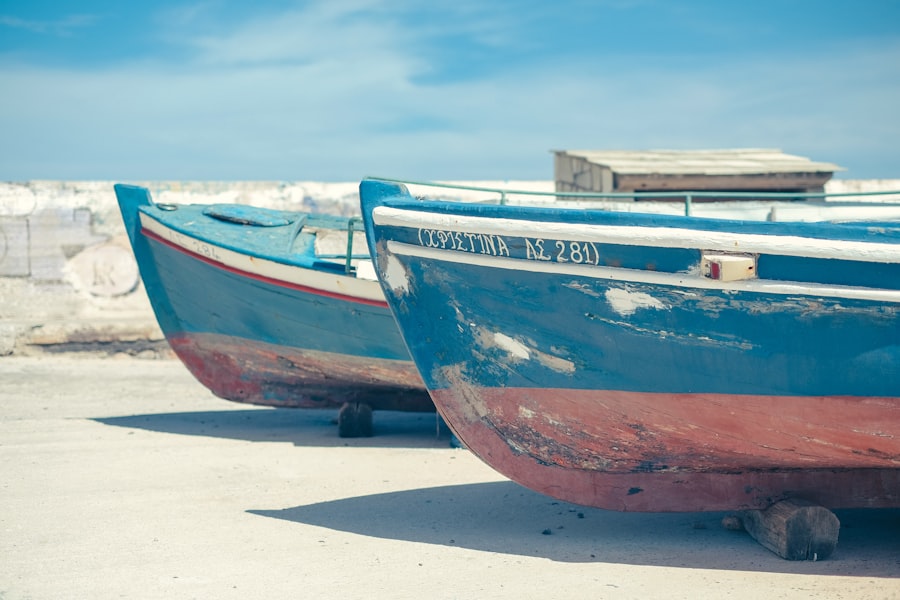Small boats offer a unique blend of accessibility, versatility, and affordability that appeals to a wide range of boating enthusiasts. One of the primary benefits of small boats is their ease of handling. Unlike larger vessels, which often require specialized training and experience to operate safely, small boats can be maneuvered by individuals with minimal boating experience.
This accessibility makes them an excellent choice for families, casual boaters, and those new to the water. Additionally, small boats are typically lighter and more compact, allowing for easier transportation and storage. Many can be towed by standard vehicles, eliminating the need for a dedicated boat trailer or larger towing vehicle.
Another significant advantage of small boats is their affordability. The initial purchase price of a small boat is generally much lower than that of larger vessels, making them an attractive option for budget-conscious buyers. Furthermore, smaller boats often incur lower maintenance costs, fuel expenses, and insurance premiums.
This financial accessibility opens up the world of boating to a broader audience, allowing more people to enjoy the recreational and therapeutic benefits of being on the water. Whether it’s fishing, exploring coastal areas, or simply enjoying a day out with family and friends, small boats provide an economical way to engage in these activities without breaking the bank.
Key Takeaways
- Small boats offer versatility, affordability, and easy handling for various water activities.
- Selecting the right boat depends on your intended use, size preferences, and budget.
- Inspecting a used boat thoroughly and checking its history can prevent costly mistakes.
- Regular maintenance and proper care extend the lifespan and performance of small boats.
- Equipping your boat with essential gear and following safety guidelines ensures enjoyable and secure outings.
Choosing the Right Small Boat for Your Needs
Selecting the right small boat requires careful consideration of various factors that align with your intended use and personal preferences. First and foremost, it is essential to define the primary purpose of the boat. Are you looking for a vessel primarily for fishing, leisure cruising, or perhaps water sports?
Each activity has specific requirements that can significantly influence your choice. For instance, if fishing is your main goal, you might want to consider a small fishing boat equipped with features like rod holders, live wells, and ample storage for tackle. On the other hand, if leisurely cruising is your priority, a small sailboat or a comfortable runabout might be more suitable.
Another critical aspect to consider is the type of water where you plan to use the boat. Will you be navigating calm lakes, rivers, or coastal waters? Different boats are designed for various environments; for example, a flat-bottomed skiff is ideal for shallow waters, while a deep-V hull is better suited for rougher seas.
Additionally, think about the number of passengers you expect to accommodate regularly. Some small boats can comfortably seat two or three people, while others may have room for a larger group. Understanding your needs will help narrow down your options and ensure that you select a boat that enhances your on-water experience.
Tips for Buying a Used Small Boat

Purchasing a used small boat can be an excellent way to save money while still acquiring a quality vessel. However, it requires diligence and attention to detail to ensure you make a sound investment. One of the first steps in this process is to conduct thorough research on the specific make and model you are interested in.
Familiarize yourself with common issues associated with that particular boat type and read reviews from other owners. This knowledge will empower you during negotiations and help you identify potential red flags when inspecting a used boat. When inspecting a used small boat, pay close attention to its overall condition.
Look for signs of wear and tear, such as cracks in the hull, rust on metal components, or frayed upholstery. It’s also wise to check the engine’s condition if applicable; ask for maintenance records and inquire about any repairs that have been made. A sea trial is another crucial step in the buying process; this allows you to experience how the boat handles on the water and assess its performance firsthand.
If possible, consider having a marine surveyor evaluate the boat before finalizing your purchase. Their expertise can uncover hidden issues that may not be immediately apparent to an untrained eye.
Small Boat Maintenance and Care
| Maintenance Task | Frequency | Tools/Materials Needed | Estimated Time | Notes |
|---|---|---|---|---|
| Hull Cleaning | Monthly | Soft brush, mild detergent, water hose | 1-2 hours | Prevents algae and barnacle buildup |
| Engine Oil Change | Every 50 hours of use or annually | Engine oil, oil filter, wrench, oil pan | 1 hour | Use manufacturer recommended oil type |
| Battery Check | Monthly | Multimeter, battery terminal cleaner | 30 minutes | Ensure terminals are clean and connections tight |
| Propeller Inspection | Every 3 months | Wrench, flashlight | 30 minutes | Check for damage or debris |
| Bilge Pump Test | Monthly | Water source to simulate bilge water | 15 minutes | Ensure pump activates and drains properly |
| Fuel System Inspection | Every 6 months | Fuel line clamps, fuel stabilizer | 1 hour | Check for leaks and replace old fuel |
| Canvas and Upholstery Care | Quarterly | Fabric cleaner, UV protectant spray | 1 hour | Prevents mildew and sun damage |
| Winterization | Annually (before winter) | Antifreeze, fuel stabilizer, fogging oil | 3-4 hours | Protects engine and systems from freezing |
Proper maintenance is essential for ensuring the longevity and performance of your small boat. Regular upkeep not only enhances safety but also preserves the vessel’s value over time. One of the most critical aspects of boat maintenance is cleaning.
After each outing, it’s advisable to rinse off saltwater or debris from freshwater to prevent corrosion and buildup. Pay special attention to areas like the hull, deck, and any storage compartments where dirt and moisture can accumulate. Using appropriate cleaning products designed for marine use will help protect surfaces while keeping them looking their best.
In addition to cleaning, routine inspections are vital for identifying potential issues before they escalate into costly repairs. Check the engine oil levels regularly and replace filters as needed. Inspect electrical systems for any signs of wear or corrosion, particularly connections that may be exposed to moisture.
Additionally, ensure that safety equipment such as life jackets, flares, and fire extinguishers are in good condition and easily accessible. Seasonal maintenance tasks should also be performed; for example, winterizing your boat if you live in a region with cold winters can prevent damage from freezing temperatures.
Essential Gear for Small Boat Adventures
Equipping your small boat with the right gear can significantly enhance your on-water experience and ensure safety during your adventures. One of the most critical items is personal flotation devices (PFDs). Every passenger should have access to a properly fitting life jacket that meets safety standards.
In addition to PFDs, consider carrying other safety equipment such as a first aid kit, signaling devices like whistles or flares, and a fire extinguisher. These items are essential for addressing emergencies that may arise while on the water. Beyond safety gear, having appropriate navigation tools is crucial for exploring unfamiliar waters.
A reliable marine GPS system can help you chart your course and avoid hazards while providing real-time information about your location. Additionally, carrying paper charts as a backup is wise in case electronic devices fail due to battery issues or other malfunctions. Other useful gear includes anchors for securing your boat when fishing or swimming, coolers for food and beverages, and fishing gear if angling is part of your plans.
Investing in quality equipment tailored to your activities will enhance your enjoyment and safety during every outing.
Safety Tips for Small Boat Owners

Safety should always be a top priority for small boat owners and operators. One fundamental rule is to ensure that everyone on board understands basic boating safety protocols before setting out on any trip. This includes knowing how to properly wear life jackets, understanding hand signals for communication while on the water, and being aware of emergency procedures in case of capsizing or other incidents.
Conducting a safety briefing before departure can help instill confidence among passengers and prepare them for unexpected situations. Another essential aspect of boating safety is being aware of weather conditions and local regulations. Before heading out, check weather forecasts to avoid storms or high winds that could create dangerous conditions on the water.
Familiarize yourself with local boating laws regarding speed limits, no-wake zones, and restricted areas where anchoring may not be permitted. Additionally, always inform someone on land about your planned route and expected return time; this precaution ensures that someone will know if you encounter difficulties during your outing.
Exploring Different Types of Small Boats
The world of small boats encompasses a diverse array of types designed for various activities and environments. Among the most popular categories are inflatable boats, which are lightweight and portable—ideal for casual outings or as tenders for larger vessels. These boats are often made from durable materials that resist punctures and abrasions while providing stability on the water.
Another common type is the kayak or canoe, which offers an intimate way to explore lakes and rivers while providing excellent exercise opportunities. Kayaks come in various styles tailored for different uses—recreational kayaks are great for leisurely paddling, while touring kayaks are designed for longer journeys with added storage capacity. Canoes provide ample space for multiple passengers or gear but require more effort to paddle compared to kayaks.
Sailboats also fall under the category of small boats; they offer a unique sailing experience that combines skill with nature’s elements. Small sailboats can range from simple dinghies suitable for beginners to more complex models designed for racing enthusiasts. Each type presents its own set of challenges and rewards, making it essential for prospective buyers to consider their interests when exploring options.
Finding the Best Deals on Small Boats for Sale
When searching for small boats for sale, savvy buyers should employ various strategies to secure the best deals available in their area or online marketplaces. One effective approach is to explore local classifieds or online platforms dedicated to boating sales such as Boat Trader or Craigslist. These platforms often feature listings from private sellers looking to offload their vessels at competitive prices compared to dealerships.
Attending boat shows or local marine expos can also provide valuable opportunities to discover deals on new or used boats while allowing potential buyers to compare different models side by side. Many manufacturers offer promotional pricing during these events or provide incentives such as financing options that make purchasing more accessible. Networking within local boating communities can yield additional leads on available boats; fellow enthusiasts may know someone looking to sell their vessel or have insights into upcoming sales events in the area.
By combining these strategies with thorough research on specific models and market trends, buyers can position themselves favorably when negotiating prices and ultimately find a small boat that meets their needs without exceeding their budget.


